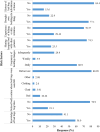Participatory epidemiological approaches for risk assessment of bed bug (Insecta: Hemiptera: Cimicidae) infestation in public hospitals in the city of Faisalabad, Punjab, Pakistan
- PMID: 39893423
- PMCID: PMC11787733
- DOI: 10.1186/s12889-025-21661-3
Participatory epidemiological approaches for risk assessment of bed bug (Insecta: Hemiptera: Cimicidae) infestation in public hospitals in the city of Faisalabad, Punjab, Pakistan
Abstract
This study was to determine risk assessment associated with bed bugs (Insecta: Hemiptera: Cimicidae) using participatory epidemiological tools in the selected public hospitals of district Faisalabad, Punjab, Pakistan. Bed bugs were collected and morphologically identified through a standard taxonomic key. A descriptive cross-sectional survey of patients using a pre-designed questionnaire containing open-ended and closed-ended questions was conducted for six months between January 2023 and June 2023. Of the 384 participants, 113 (29.43%) had experienced itching or skin irritation presumably from the bed bug feeding activity. The study further revealed patients above age 40 (35.43%) and males (30.57%) experienced greater skin irritation responses compared to other participants. Among administrative divisions (tehsils) in the city of Faisalabad, Tehsil Sadar had the highest number of participants with itching or skin irritation (35.48%), while Tehsil Chak Jhumra had the lowest number (24.62%). Most observations of bed bugs by patients were in their beds (10.42%), with chairs (3.91%) being the second most reported location. However, we found bed bugs from only 17 (4.42%) beds and 5 (1.30%) from chairs. A majority of patients (60.9%) reported daily change of bedding; however, a significant proportion (29.9%) reported infrequent changes. About 25.5% of the patients shared beds with others and about 77.1% of patients brought their own bedding or clothing to the hospitals. The current study concluded that the bed bug infestation is a problem in the public hospitals of Faisalabad, Punjab, Pakistan. Risk factors such as sharing a bed, infrequent change of bedding, and bringing personal bedding to hospital while having medical treatment pose a concern.
Keywords: Cimex lectularius; Bed bug; Distribution; Infestation; Prevalence.
© 2025. The Author(s).
Conflict of interest statement
Declarations. Ethics approval and consent to participate: This study was approved by the Research Ethics Committee, Faculty of Veterinary Science, University of Agriculture, Faisalabad, Pakistan vide letter No. MPL 637/11–22. The standard guidelines for human and institutional animal care and use, University of Agriculture, Faisalabad, Pakistan, were followed. The study was conducted in full compliance with the Declaration of Helsinki and adhered to all appropriate national guidelines for research involving human participants. Informed consent to participate was obtained from all participants involved in the study. For participants under the age of 18, informed consent was obtained from their parents or legal guardians, as per ethical guidelines. Consent for publication: Consent for publication of data collected through questionnaire was obtained. However, identifying images or other personal or clinical details of participants was not obtained and not applicable for this study. Competing interests: The authors declare no competing interests.
Figures


Similar articles
-
Assessment of Tropical Bed Bug (Hemiptera: Cimicidae), Infestations in Cape Coast, Ghana: Household Control Practices and Efficacy of Commercial Insecticides and Long-Lasting Insecticidal Nets Against Field Bed Bugs.J Med Entomol. 2021 Jul 16;58(4):1788-1797. doi: 10.1093/jme/tjab042. J Med Entomol. 2021. PMID: 33822124 Free PMC article.
-
Horizontal transfer of diatomaceous earth and botanical insecticides in the common bed bug, Cimex lectularius L.; hemiptera: cimicidae.PLoS One. 2013 Sep 25;8(9):e75626. doi: 10.1371/journal.pone.0075626. eCollection 2013. PLoS One. 2013. PMID: 24086593 Free PMC article.
-
A Case Study on Tropical Bed Bug, Cimex hemipterus (Hemiptera: Cimicidae) Infestation and Management in Dormitories.J Econ Entomol. 2023 Feb 10;116(1):5-11. doi: 10.1093/jee/toac055. J Econ Entomol. 2023. PMID: 35511752
-
Bed bugs (Cimex lectularius) and clinical consequences of their bites.JAMA. 2009 Apr 1;301(13):1358-66. doi: 10.1001/jama.2009.405. JAMA. 2009. PMID: 19336711 Review.
-
Historical and Contemporary Control Options Against Bed Bugs, Cimex spp.Annu Rev Entomol. 2023 Jan 23;68:169-190. doi: 10.1146/annurev-ento-120220-015010. Epub 2022 Oct 5. Annu Rev Entomol. 2023. PMID: 36198396 Review.
References
-
- Amin H, Mehmood M, Sarwar H, Razzaq A, Farooq U, Mushtaq F, Ali M. Bedbug infestation in Lahore hospitals. East Mediterr Health J. 2023;29(3):212–6. 10.26719/emhj.23.021. - PubMed
-
- Balvín O, Munclinger P, Kratochvíl L, Vilímová J. Mitochondrial DNA and morphology show independent evolutionary histories of bedbug Cimex lectularius (Heteroptera: Cimicidae) on bats and humans. Parasitol Res. 2012;111(2):457–69. - PubMed
MeSH terms
Grants and funding
LinkOut - more resources
Full Text Sources
Medical
Miscellaneous

